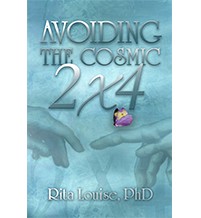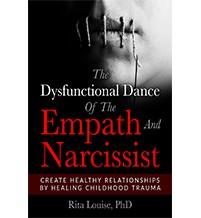Use Mindfulness To Stop Runaway Cycles Of Negative Thinking
Many of us live our lives on autopilot. We exist day to day programmed like an automaton and never consider the choices we have. We let our old habits dominate what we do and what we think. We have walked down the same familiar well worn path for so long that we assume this is what life is all about. We unwittingly accept it and do not believe that it can be better or different. We can become so entrenched in our habitual patterns that we do not even realize that we are not living but are only surviving.
If thoughts of peace and serenity are the goal, where are you now? We all have moments when life events disturb our inner world. Depending on what it is, we may be able to naturally emotionally regulate and quickly recover our composure, thus returning to our normal healthy and happy state. At other times, situations can set something off within us that we may find difficult if not impossible to shake off. If your inner world is in disarray, you will never be content or happy. If you think about it, when you are caught up in cycle of worry or rumination you are bogged down living with an internal world filled with pain, shame, self-criticism or judgment. You are not happy. You are hurting.
Many trauma survivors, when triggered, reflexively get caught up in a runaway cycle negative thinking. Their inner child’s deep seated fears and insecurities may come center stage and end up running the show. Their bodies and mind may be unable to rest because they are stuck in a stress response, fight, flight, freeze or fawn.
Life Challenges And The Present Moment
When something upsetting happens to us, our inner wounding can get triggered which causes a number of things to happen. First and foremost, the quantity or quality of subtle energy that moves through our energy channels becomes impaired. Our ability to ground becomes diminished. This dynamic causes us to hold on to the negative thoughts and emotions that may have been activated. These discordant vibrations become trapped within us making it difficult to be in the present moment.
When we are not in the present moment, we miss out on life as it unfolds before us. We are not experiencing what is happening right here and right now. Instead, our thoughts are either in the past or in the future. We may not realize we have mentally digressed while in this state and may believe that we are utilizing our mental energy in a helpful productive way. Triggering often brings on a cascade of thoughts that can keep us in a negative thought pattern, out of the present moment and missing out on life. One symptom is the formation of intrusive thoughts.
Intrusive Thoughts Interfere With Our Ability To Live In The Present Moment
It is normal to react emotionally to things that happen to us. If we are in good working order, a thought can come into our mind, our body may react to it, but after a short period of time we are able to let it go and move on with our life. If, however we have a high emotional response to what just occurred, our mind might want to keep the situation alive. This is the realm of intrusive thoughts.
Unwanted and intrusive thoughts are a thought pattern that is stuck in your head. It is like hearing the lyrics to a song over and over again and are unable to make them stop. These thoughts may revolve around work, our decisions or our relationships. We can have intrusive thoughts on just about any topic if there is an powerful emotional charge tied to it. Worry and rumination are the most common forms of persistent negative thinking.
Rumination
Rumination is when we over-think or obsess over a situation or event that is upsetting to us. People will often ruminate when something frustrating, threatening, or insulting happens. If you are not sure what rumination is, it is when we relive the details of an argument with a friend repetitively in our mind and just cannot let it go. Many times we do not even realize we are ruminating. Regardless of what we do to shake it off, our minds keep coming back to the situation trying to make sense of what happened.
Worry
Worrying is similar to rumination, where our minds can become trapped in an endless cycle of attempting to figure things out. The key difference between the two is that people who ruminate focus their mental energy on resolving past events, while worriers focus on the future.
Worry is a cycle of living with the question “what if” in the forefront. When we worry, we imagine potential outcomes to an unknown event. We worry in an attempt to solve suspected problems in our lives. We all have moments when we worry. It is when our thoughts become persistent and uncontrollable that they become a cause for concern. Worry can be the first stage in a much larger negative thinking process. It often underscores the manifestation of its much more insidious forms: anxiety and panic, with worry on the mild side of the spectrum and a full blown panic attack on the other.
Mindfulness & Healing The Out Of Control Mind
It is in these challenging moments that healing can occur. The trick? Paying attention to what is going on inside. The act of raising our awareness to our inner world is called ‘mindfulness’. Mindfulness, by default, puts us into the present moment. It helps us to stop over thinking and draws our attention back to what is going on in the here and now. This simple change can literally transform you from the inside out.
As you begin to focus your time and attention on yourself you may start to detect patterns of negative thoughts invading your inner world. Our runaway disparaging thinking can unequivocally impact our ability to moderate our emotional pain and inhibit our ability to emotionally regulate. When we indulge in unhealthy thinking we reinforce our negative feelings about ourselves which further chips away at our self-esteem. These thoughts are not new. They evolved over time and throughout our lives. It is only now that you are turning off your autopilot that you may be noticing them.
What Life Feels Like To Be In The Present Moment
You may wonder what it is like to be in the present moment. When we are in the present moment, we feel whole, confident, powerful and secure. We are firmly planted in our bodies. Our subtle life force energy (chi) readily flows into the top of our heads, via our seventh chakra, through our physical body and out through our grounding cord by way of the first chakra. In this state we feel calm and relaxed. Our anxiety is low or absent and life’s little difficulties have a hard time sticking to us.
How Our Brain Works
We often think that our minds are filled with hundreds if not thousands of thoughts all speaking to us at the same time. This belief is a fallacy. The reality is, we can only have one thought occupying our mind at a time. The constant barrage of ideas, opinions and beliefs passing through our awareness are all competing for the same mental slot available in our consciousness.
Said simply, if you are thinking about your upcoming adventurous outing with friends, then that is your one thought. In turn, if you are obsessing about how your ex was a dirty downright scoundrel, then this is the thought filling your solitary cognitive spot. Granted, our thoughts can jump from one concept to another at lightning speed, but only one thought can take front and center within our awareness at a time.
This small detail of how our mind works can be exploited to support our healing. We can employ it by purposefully redirecting our one thought from a destructive intrusive one to anything of our choosing. This can be achieved by paying attention to our inner environment, our thoughts, feeling and body sensations and making a conscious choice about what to do with them in any given moment.
What To Do, What To Do: How To Get Back Into The Present Moment
Being and living in the present moment is easy to say but a bit more challenging to achieve. It requires us to raise our awareness and become mindful of our thoughts. Are we at work reliving an encounter with our boss or are we feverishly anticipating the results of a test we just took. In both cases, we are not in the present moment.
The practice of mindfulness is just that, a practice. It is something that needs to be repeated over and over again until we change our internal habitual patterns from unhealthy ones to ones filled with increased joy and wonder. In my work, I have found that a combination of two different techniques blend beautifully together support our ability come back into the present moment. It might not work well the first time, but with a little persistence you will see dramatic results.
Mindfulness Practices
When you are feeling anxious, upset, hurt or frustrated, there is a disruption in “the force”. One of your inner wounds, a previous trauma, or a negative core belief may have become activated. There may be a conflict between what you and your authentic self wants and the precepts stored in your unconscious mind. You can, however, use these moments to become our own private detective and solve the mystery of what happened and why.
Identifying what set you off can be challenging to determine but by getting to know what elicits your negative responses you can ready the stage for profound healing. You may even begin to consider the origin of your triggers and work to heal those things that unwittingly activate the tender parts, the wounded inner child inside of you. You will begin, in time, to feel whole and strong and will be better able to navigate the same scenarios that once distressed you.
By being mindful of your thoughts, especially your intrusive ones, you can begin to calm down what has been flared up and hopefully let go of the rest. They can be easier to control and even prevented if you can catch them early on instead of waiting until you are in the midst of a full blown meltdown.
One way of supporting our ability to ‘be’ is through mindfulness techniques and meditation. Some people suggest that self-improvement techniques such as meditation or mindfulness are hard or even exhausting. What is even more taxing on your body and soul is the underlying stress negative thoughts and emotions can have.
Simple Mindfulness Techniques
One simple mindfulness technique you can use is called the ho’oponopono. The ho’oponopono is a Hawaiian meditative practice of reconciliation and forgiveness. It consists of four simple statements:
I’m sorry,
Please forgive me,
I love you,
Thank you.
The ho’oponopono is similar to an affirmation where it is repeated multiple times. This chant projects the energy of acceptance, grounding and neutrality. If you find yourself plagued by intrusive thoughts, consider repeating the ho’oponopono. This mindfulness practice can be used to shift your mind’s focus away from your problems to one of healing.
Tied to this is breathing! Breathing is a great tool for calming both the sympathetic nervous system and your overtaxed mind. It naturally puts your body into a relaxed state. Breathe deeply as you repeat the ho’oponopono. Feel your body and mind shift with each breath that you take. Have it move you from wherever you have been, back into the present moment.
The Mindfulness Practice Of Taking Inventory
Another way of supporting our inner transformation is by observing the dynamics of what is going on inside. Through it you can start to unwind your psyche and heal your inner wounding. This knowledge can help you identify what sets you off. Use it to make different choices, more mature choices, when an uncomfortable situation is encountered. It also causes you to pause and hopefully respond more skillfully. You can step out of your habitual patterns and view a situation from a more expanded perspective with it.
When you feel anxious, worried or afraid take a few deep breaths. This will help to calm down your body and quiet your mind. Remind yourself that these are just emotions triggered by your thoughts. It is okay to feel these things. Let them just ‘be’ without trying to manipulate or change the experience. Do not try to push them away. The more you struggle with them the stronger they can become and the more entangled you can get with them.
Instead, ask them what they are trying to reveal to you. A question you might want to internalize is “why?” What just happened that stirred me up? Why am I feeling so anxious? What thoughts keep rolling around in my mind that are disturbing my internal world? What concept keeps coming back trying to fill my mental slot? What am I feeling in my body while all of this is going on?
Perhaps, the recent triggering event is only sitting on the surface of something much deeper. Maybe what actually got activated is the pain from a wound that occurred in your distant past. Open yourself up to this possibility. Ask you higher self to reveal its origin and support you as you work to uncover the submerged trauma. Keep breathing as you work through this process.
The Mindfulness Practice Of Working With Worry
If worry and anxiety is where your mind traditionally goes when a challenging situation presents itself, then perhaps asking yourself some basic questions can resolve or at least lessen the fear you are experiencing. Check in and inquire, “Is it really that bad?” “What is the worst thing that could happen?” “What steps can I take to resolve this situation?” Questions such as these support you as you begin to take control of what is going on inside. They help shift you from a place of helplessness to a proactive one, one in which you may feel like you are in control of your destiny.
The Mindfulness Practice Of Taking A Worry Break
You might also want to try the strategy of postponing your negative thoughts. If you find yourself going in for another round of rumination or worry, instead of trying to stop your thoughts or get rid of them, give yourself permission to put them off until a later designated time. Tell yourself you do not need to think about it right now. You can go back and deal with these issues during its assigned time be it later in the day or even the following week. Sometimes just by putting them off you can stop feeding negative thoughts and the associated momentum. You may find that this technique can help you let go of them entirely.
The Mindfulness Practice Of Talking It Out
Sometimes it is a good idea to talk to someone about what you are thinking and feeling. It can provide you with the opportunity to unravel what may seem like a jumbled up confusing mess in your mind. It can also help you to delve deeper into your underlying issues rather than just dealing with them on surface levels. Whether you go talk to a counselor or a good friend, the act of vocalized and expressing what is going on can be very healing. Sometimes just hearing yourself speak can help you to sort things out. Journaling is also another wonderful technique you can use to sort out your thoughts and make sense of what is going on if there is not anyone to can readily go to.
Let me help you with your mindfulness practice and find inner peace!
Taking action is the key to making positive changes in your life. This includes your health. So don’t wait! Take your next step right now and contact Dr. Rita to schedule a private consultation.
Medical Intuitive Reading – Intuitive Counseling – Energy Healing
© Copyright Rita Louise, Inc. – soulhealer.com. All rights reserved.





